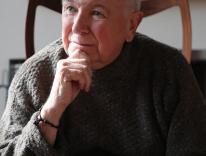It’s odd to imagine Tom Stoppard as a fan of classic rock. Post-Romantic orchestral works, or maybe Baroque fugues, seem a better match for his plays, which inevitably weave ideas into dizzying symphonic and contrapuntal patterns.
Yet in the November issue of Vanity Fair, Stoppard confessed that he wrote Ar¬ca¬dia while listening to the Rolling Stones’s “You Can’t Always Get What You Want,” and penned The Coast of Utopia while hit¬ting the repeat button on-yikes!-Pink Floyd’s “Comfortably Numb.”
For further evidence of the playwright’s improbable taste in tunes, there’s Rock ’n’ Roll, which opened on Broadway in early November after a run in England. A tale of political idealism and pragmatism in twentieth-century England and Czechoslovakia, the play samples numerous favorites from the vinyl era, drawing an implicit parallel between musical rebelliousness and democratic iconoclasm. Unfortunately, the amped-up pop-culture motif doesn’t do enough for the show’s accessibility: Rock ’n’ Roll is a streamlined turbine of political discourse and historical allusion, lacking the delightful whimsy that characterizes much of Stoppard’s work. Even the brainy epic The Coast of Utopia had a certain playfulness about it: Rock ’n’ Roll just feels argumentative.
The three-hour drama focuses on two figures: Max, a Cambridge professor who’s a dyed-in-the-wool Communist, and Jan, a student and rock fan who returns to his native Czechoslovakia in 1968, as the Soviets invade. Over the course of two decades, the two men weather personal and geopolitical tribulations, and Jan involuntarily becomes a dissident. Meanwhile, off-stage, rock music alters history, as the 1976 arrest of a band, the Plastic People of the Universe, catalyzes the Czech protest movement known as Charter 77.
Tracing these events, Rock ’n’ Roll toggles between Prague and Cambridge settings, each suggested by a hint of city skyline suspended at the top of Robert Jones’s garden-and-interiors set. No matter what the locale, the dialogue tends to smack of Political Theory 101 and there’s not enough idiosyncratic personal communication to balance out the rhetoric. “The Party is losing confidence in its creed,” Max complains, in one typical remark. “If capitalism can be destroyed by antiracism, feminism, gay rights, ecological good practice, and every special interest already covered by the Social Democrats, is there a lot of point in being a Communist?-to spend one’s life explaining: no, Stalin wasn’t it, either?”
Even the high-powered actors in the Broadway production, directed by Trevor Nunn, can’t wholly humanize this kind of speech. Star Rufus Sewell comes closest to succeeding: his Jan ages perceptibly during the course of the show, becoming frailer and more physically hesitant and lending poignancy to the play’s denouement, which takes place after the fall of the Iron Curtain. Watching the gray-haired Jan enjoy a blast of the Rolling Stones, you feel that political theories are almost beside the point: this man has triumphed simply by surviving.
In another relatively appealing performance, Sinead Cusack brings out both the vulnerability and the fierceness in Max’s dying wife, Eleanor, who thinks that her own cancer refutes her husband’s materialist worldview (“I am not my body. My body is nothing without me, that’s the truth of it”). Cusack raises the production’s emotional temperature later on, too, when she doubles as Max’s daughter Esme, a sweet, angst-ridden hippie, who has a slight obsession with ex-Pink Floyd member Syd Barrett. By contrast, Brian Cox’s vehement Max never seems much more than a vessel for a Marxism-based perspective.
Rock music is such a powerful presence in the play that it’s virtually another character. Songs-by Bob Dylan, U2, the Velvet Underground, and more-provide segues between scenes, sometimes seeming to comment elliptically on the action. Nunn telegraphs the music’s importance with a rather irritating device. As a song blares, credits for the sampled track scroll across a scrim-the title of the song, the date, the name of the recording studio, and even which musicians played which instruments. Nunn obviously means for the sequences to suggest the obsessive mindset of a music fan, but the credit-scrolling takes far too long, ultimately helping to make Rock ’n’ Roll seem more like an elaborate blueprint than a glimpse into a full theatrical world.
That flaw may seem curious, since Stoppard has a personal connection to this material: he was born in Czechoslovakia; his family, like Jan’s, fled the Nazis, ultimately ending up in England. In the introduction to the Grove Press edition of Rock ’n’ Roll, Stoppard admits that the character of Jan incorporates autobiographical elements: in the play’s first draft, in fact, Jan was named Tomas, Stoppard’s birth name.
Perhaps it’s precisely that personal investment that has sapped Rock ’n’ Roll of typical Stoppardian playfulness: the hyper-literate whimsy that burst on the scene with Rosencrantz and Guildenstern Are Dead forty years ago may rely on a certain psychological distance. When one feels strongly about something, it’s harder to joke about it. An intellectual juggler can’t demonstrate legerdemain if he never lets go of the balls.
Please email comments to [email protected] and join the conversation on our Facebook page.
Share
Previous Story
Take & Read
Next Story
The Mary We Never Knew

